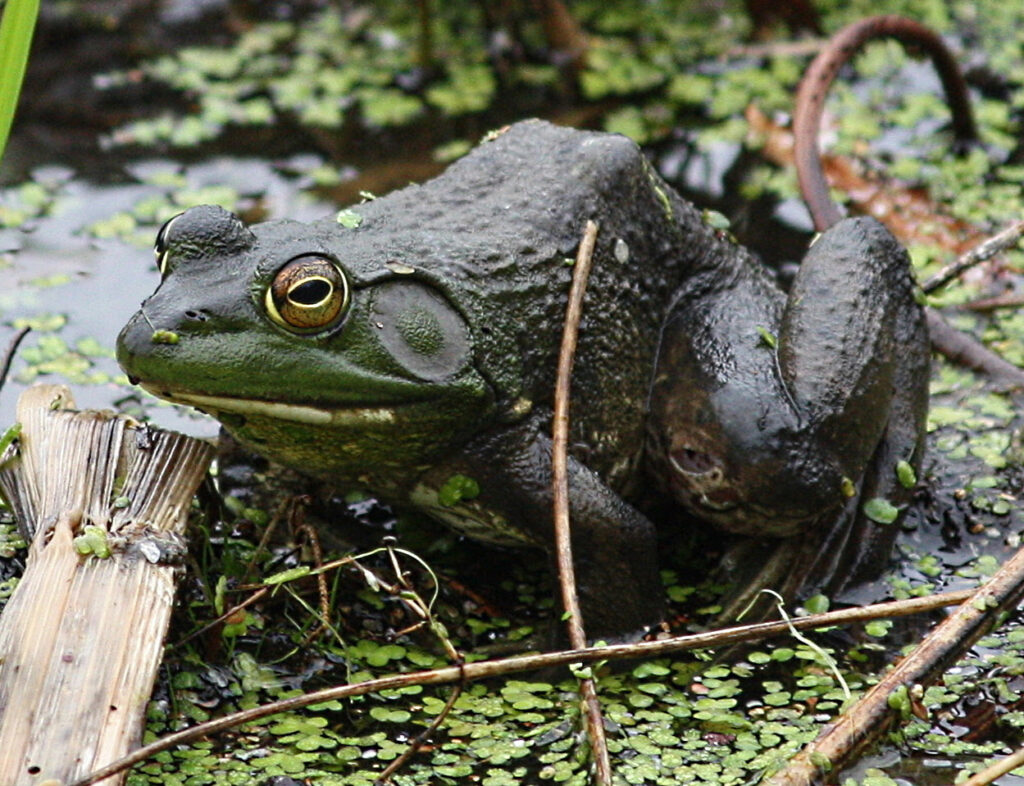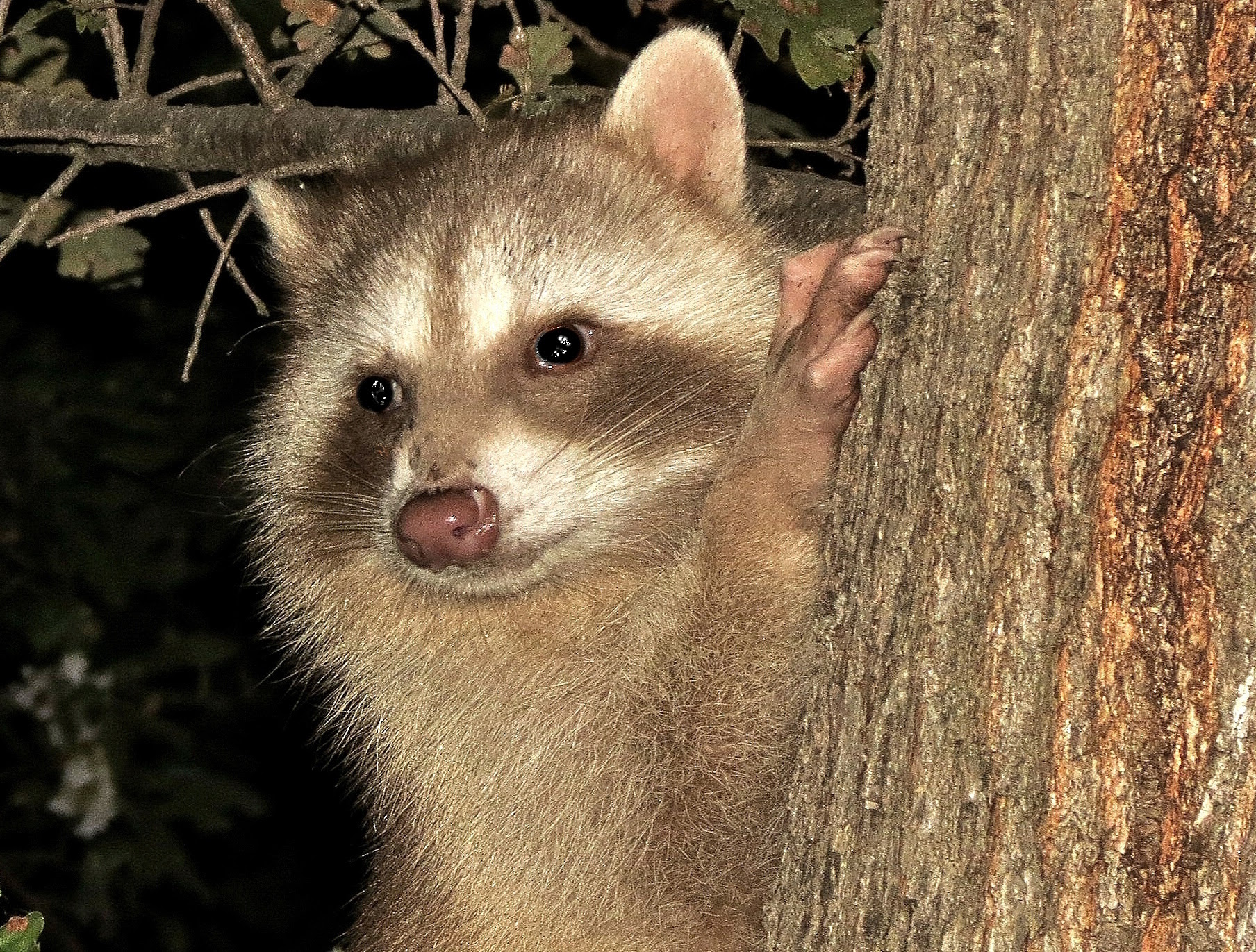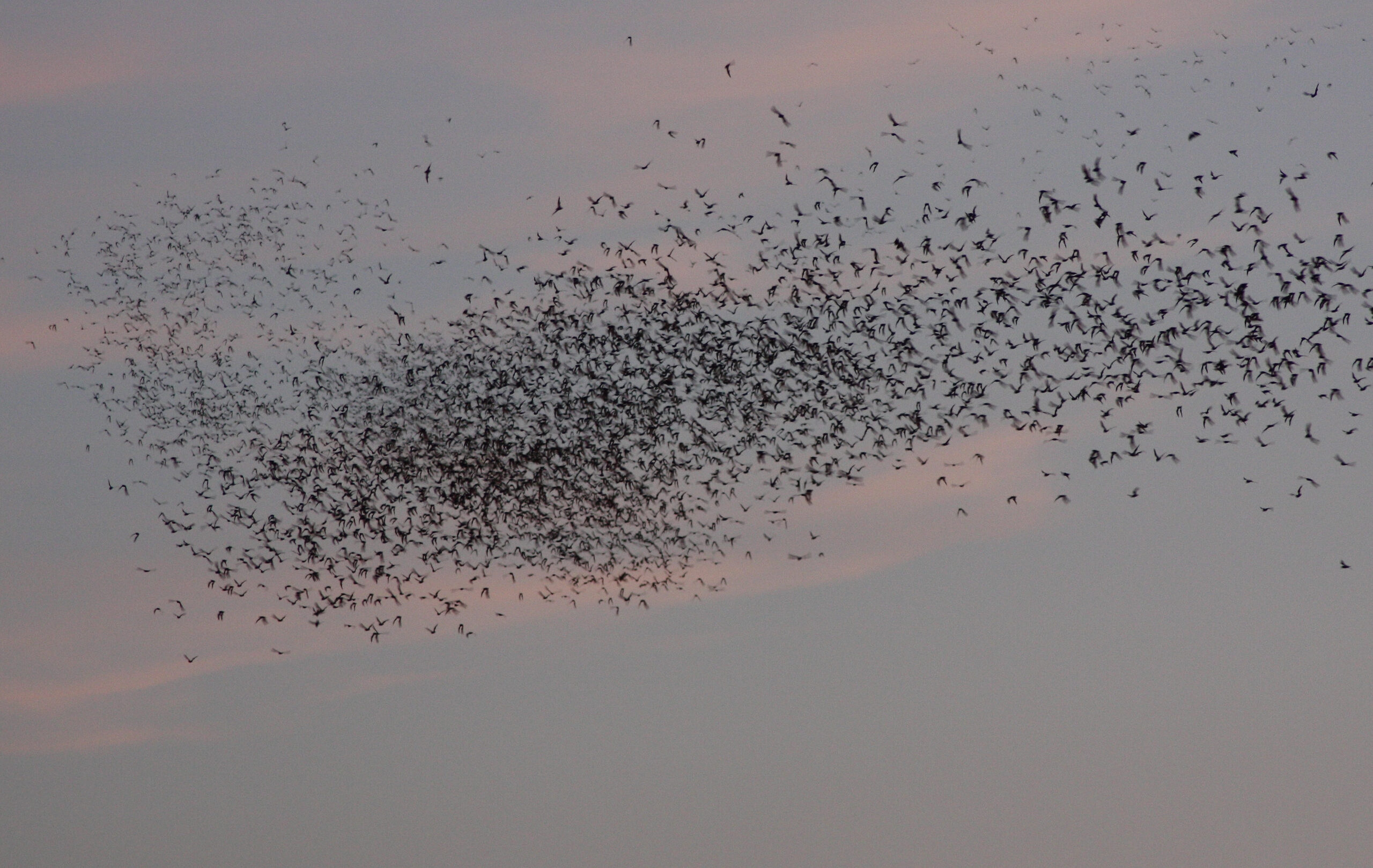At eight inches in length and a weight of more than a pound, the American bullfrog (Rana catesbeiana or Lithobates catesbeianus) is the largest frog in North America. Bullfrogs are native to eastern North America as far west as Kansas and north to Newfoundland. Almost any body of water from lakes to irrigation ditches is suitable habitat. Because they have large meaty legs, they were introduced in many countries as a source of food. Today, American bullfrogs are found in the western U.S., Cuba, South America, Europe, China, Japan, and Southeast Asia. Both sexes are some shade of green. Males are readily distinguished by their yellow throats and tympana (ear drums) that are larger than their eyes. The tympana of females are equal or smaller than their eyes. Tadpoles of bullfrogs initially filter and eat algae, zooplankton, and organic matter. Later, they graze on algae and occasionally on fish and amphibian egg masses using their teeth for rasping. Tadpoles may metamorphose into adults in a single year or remain as tadpoles for as long as three years in cool climates. Adults are gape-limited predators, meaning that they will eat any animal they can overpower and fit in their mouths. In a study of the diet of bullfrogs on southern Vancouver Island, the contents of over 5,000 bullfrog stomachs were examined. Insects, by far, were the most common prey, followed by spiders, crabs, snails, and salamanders and frogs. Fish, worms, and millipedes were also eaten. Prey rarely consumed included mammals, birds, and turtles and other reptiles (Jancowski, K., and Orchard, S. 2013. NeoBiota 16:17-37). There are other reports of American bullfrogs eating scorpions and rattlesnakes. In the Yolo Bypass, crayfish are probably high on the menu. Bullfrog adults are an important food for birds like herons and egrets, otters, fish, and snakes. However, bullfrog eggs and larvae are unpalatable to many animals.

Photo by Mike Davis
Bullfrogs produce several calls. The familiar advertisement call of males is a loud, low-pitched bellow, reminiscent of a bull (thus, the frog’s common name). Sometimes boisterous male bullfrogs aggregate into groups called choruses to attract females. Bullfrogs also make chirps just before they jump into water to escape danger, a short low-pitched call during an encounter with another male, and a loud open-mouthed scream when under extreme stress, possibly to startle an attacker.
Wherever they have been introduced, whether for aquaculture to satisfy demand for their edible legs, as a biological control of pests, for jumping competitions, the pet trade, or dissection in schools, they invariably escape. Bullfrogs often become established in a new area because of their generalist feeding habits, ability to tolerate a range of climates, competitiveness due to their large size and other defenses, and extreme fecundity (females lay batches of up to 20,000 eggs). Bullfrogs were first introduced in California in the 1910s for aquaculture and now occur throughout the state except in deserts and high mountains. Although bullfrogs are no longer farmed in the state, about two million bullfrogs are imported into California annually and sold in live food markets. Most are imported from Asia and South America (Savethefrogs.com). Current importation permits require that animals sold must be euthanized before leaving the retail premises, but that is difficult to enforce.
Outside their native range, bullfrogs have caused havoc in many ecosystems. According to the International Union for Conservation of Nature, American bullfrogs are among one hundred of the world’s worst invasive species. In California, all life stages of California red-legged frogs are preyed upon by bullfrogs. As a result, the red-legged frog has been extirpated from nearly all of its habitats that are now occupied by bullfrogs. Other California animals negatively impacted by bullfrogs include the California tiger salamander, yellow-legged frog, and giant garter snake, among others. And bullfrogs are vectors of disease-causing pathogens linked to worldwide amphibian decline—the chytrid fungus Batrachochytrium dendrobatidis, which causes chytridiomycosis, and ranaviruses. In California, the chytrid is responsible for near-extinction of the yellow-legged frog in the Sierra Nevada. Because the bullfrog is relatively immune to chytridiomycosis, it can spread the pathogen with impunity to susceptible species of frogs as it invades new territories. In one study, up to 62% of frogs imported into the U.S. were infected with the chytrid, and 8.5% were infected with ranaviruses (Schloegel, L., et al. 2009. Biol. Conserv. 142:1420–26).
Efforts to reduce the damaging impacts of bullfrogs on local ecosystems are in place all over the world. For example, in the European Union bullfrogs cannot be imported, bred, transported, commercialized, or intentionally released into the environment. In 2012, Santa Cruz County was the first county in the U.S. to ban the import, purchase, and sale of American bullfrogs (Ordinance 6.18.020). Starting in 2005 the National Park Service began bullfrog removal from Yosemite Valley by hand, net, and spears. Perseverance paid off—the last bullfrog was caught in 2019. The Park Service was then able to introduce California red-legged frogs back into their native habitat in Yosemite. This was the first published successful eradication of bullfrogs on a landscape level (Kamoroff, C., et al. 2020. Biol Invasions 22:617–626). Another example of bullfrog control is the 3n-Bullfrog project in Belgium. Researchers manipulated bullfrog genetics to produce sterile triploid (3n) male bullfrogs for population management. Normally, animals are diploid (2n), which means there are two sets of chromosomes, one set from the mother and one from the father. By releasing triploid bullfrogs into a wild population, females that mate with the triploid males produce infertile eggs. In a triploid condition, chromosomal pairing, required for functional sorting of chromosomes, can’t occur because there is an odd set of chromosomes, resulting in sterility. It is this mechanism that produces triploid seedless watermelons. Disparate efforts like these to eliminate bullfrogs from native ecosystems illustrate the intensity and urgency of the struggle against these green, wide-mouth invaders.
Note from Yolo Basin Foundation:
To learn more about the American Bullfrog in California, please visit the California Department of Fish and Wildlife webpage on the subject.
If you observe this species in California, please report your sighting to the CDFW Invasive Species Program, by email to [email protected], or by calling (866) 440-9530.




